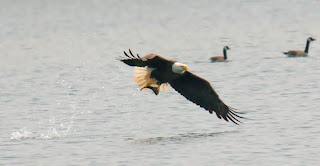Adirondack for Kids: Be A Nature Detective Bald Eagles!
Bald Eagles can be seen in the Adirondacks, Alaska, and every state but Hawaii. If you take your kids out in the Adirondacks and see a bald eagle, please remind your kids not to interfere, just observe!
If you are out on a walk or hike near a Adirondack pond or lake, you may just come across a bald eagle. Below are some fun facts to share!
Is a bald eagle really bald?
No, the word bald used to mean white-headed. The scientific name for bald eagle is Haliaeetus leucocephalus which means "white-headed sea eagle" in Latin.
How do you tell the male from the females?
Hmmm, mature males and females have the same markings of a white head and tail. The female is usually 25% larger than the male. The younger birds are solid brown. Both young and adult bald eagles have yellow legs. The young birds have a dark beak and black eyes, both of which turn bright yellow as they become adults.
How large is their wingspan?
These birds are the largest birds of prey with a wingspan up to 7 feet. Adults are 3-3.5 feet tall and weigh 8-15 lbs.
Where can you find their nests?
Usually nests are built near the top of a large tree. Enlarged annually, a bald eagle nest can become the largest of any North American bird. The record nest measured 20 feet deep, 10 feet wide and weighed two tons!
How do you tell a golden eagle from a young bald eagle?
The two are often confused. The bald eagle’s legs are featherless, while golden eagles have feathers all the way to the talons. Bald eagles glide with flat wings while golden eagles glide with their wings raised in a slight "V."
When do the young bald eagles get their distinctive white heads?
Not until they are four or five years old.
What do bald eagles eat?
Being known as the sea eagle it only makes sense that they eat fish. Though when food is scarce they are known to eat dead or crippled waterfowl, carrion (rotting flesh of a dead animal) as well as other wildlife as needed.
Having babies?
Bald eagles have two eggs a year which are incubated (sat upon) for a 35-day period. At 10 weeks the eaglets (baby eagles) are nearly full grown and can fly from the nest. They are born with eyes open and covered with grey down.
Endangered?
No more, In June of 2007, the U.S. Fish and Wildlife Service removed the bald eagle from the list of species protected by the Endangered Species Act but the eagle will be monitored for five years.
When were they endangered?
In the 1970s it was found that when DDT, a pesticide that was not banned in the US until 1972 though its dangers were known in the early 1960s, was ingested by the bald eagles it caused the shells of their eggs to weaken to the point where the eggs cracked under the weight of an adult eagle.
With the banning of DDT in 1972 and the passage of the landmark Endangered Species Act in 1973, the bald eagles have been able to make a come back.
Are these bird protected in any other way?
Yes, bald eagles are protected under the Bald and Golden Eagle Protection Act and the Migratory Bird Treaty Act. The Bald and Golden Eagle Protection Act prohibits activities that are likely to interfere with eagles’ breeding, feeding or sheltering behavior, or result in injury, death, or nest abandonment.
The Migratory Bird Treaty Act further protects bald eagles and their eggs, nests and feathers by prohibiting killing, taking, or possession of eagles without a permit from the U.S. Fish and Wildlife Service. In some states, bald eagles are also protected by state endangered species laws.
Is a bald eagle really bald?
No, the word bald used to mean white-headed. The scientific name for bald eagle is Haliaeetus leucocephalus which means "white-headed sea eagle" in Latin.
How do you tell the male from the females?
Hmmm, mature males and females have the same markings of a white head and tail. The female is usually 25% larger than the male. The younger birds are solid brown. Both young and adult bald eagles have yellow legs. The young birds have a dark beak and black eyes, both of which turn bright yellow as they become adults.
How large is their wingspan?
These birds are the largest birds of prey with a wingspan up to 7 feet. Adults are 3-3.5 feet tall and weigh 8-15 lbs.
Where can you find their nests?
Usually nests are built near the top of a large tree. Enlarged annually, a bald eagle nest can become the largest of any North American bird. The record nest measured 20 feet deep, 10 feet wide and weighed two tons!
How do you tell a golden eagle from a young bald eagle?
The two are often confused. The bald eagle’s legs are featherless, while golden eagles have feathers all the way to the talons. Bald eagles glide with flat wings while golden eagles glide with their wings raised in a slight "V."
When do the young bald eagles get their distinctive white heads?
Not until they are four or five years old.
What do bald eagles eat?
Being known as the sea eagle it only makes sense that they eat fish. Though when food is scarce they are known to eat dead or crippled waterfowl, carrion (rotting flesh of a dead animal) as well as other wildlife as needed.
Having babies?
Bald eagles have two eggs a year which are incubated (sat upon) for a 35-day period. At 10 weeks the eaglets (baby eagles) are nearly full grown and can fly from the nest. They are born with eyes open and covered with grey down.
Endangered?
No more, In June of 2007, the U.S. Fish and Wildlife Service removed the bald eagle from the list of species protected by the Endangered Species Act but the eagle will be monitored for five years.
When were they endangered?
In the 1970s it was found that when DDT, a pesticide that was not banned in the US until 1972 though its dangers were known in the early 1960s, was ingested by the bald eagles it caused the shells of their eggs to weaken to the point where the eggs cracked under the weight of an adult eagle.
With the banning of DDT in 1972 and the passage of the landmark Endangered Species Act in 1973, the bald eagles have been able to make a come back.
Are these bird protected in any other way?
Yes, bald eagles are protected under the Bald and Golden Eagle Protection Act and the Migratory Bird Treaty Act. The Bald and Golden Eagle Protection Act prohibits activities that are likely to interfere with eagles’ breeding, feeding or sheltering behavior, or result in injury, death, or nest abandonment.
The Migratory Bird Treaty Act further protects bald eagles and their eggs, nests and feathers by prohibiting killing, taking, or possession of eagles without a permit from the U.S. Fish and Wildlife Service. In some states, bald eagles are also protected by state endangered species laws.




Comments